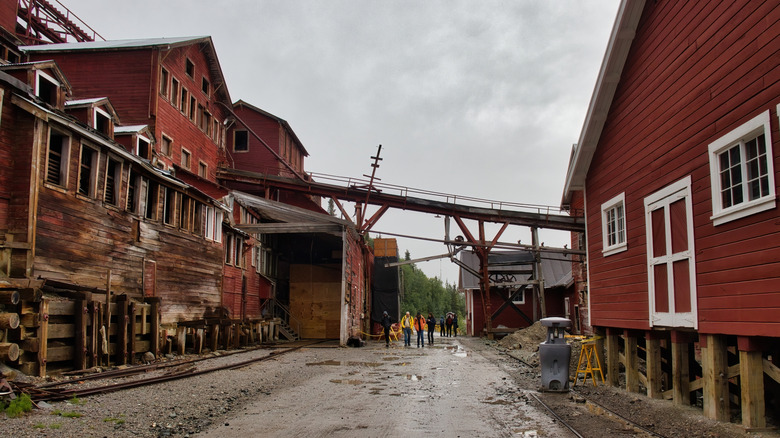Alaska's Abandoned Copper Camp Is A Wilderness Ghost Town With Mill Tours, Hikes And Icy Views
Alaska, the Last Frontier, America's Final Wilderness, is so epic that just saying its name brings forth images of sparkling ice caves, immense snow-covered mountains, Alaska's dramatic national forest with endless outdoor adventures, long Indigenous traditions, polar bears hunting off icebergs, glaciers calving right into the sea, fish bigger than a man, and yes, true wilderness. While Alaska does have many miles of virtually empty, undiscovered wilderness, it also has some hidden gems revealing the footsteps of humanity. One of these, Kennecott, is an overlooked Alaskan ghost town turned national historic landmark that will transport you back in time.
Located deep in the vast Wrangell-St. Elias National Park (which, at 13.2 million acres, is the size of about six Yellowstone National Parks), Kennecott was a remote copper mining camp that boomed during the early 20th century. Kennecott employed hundreds of miners and mined millions of dollars worth of copper until it was virtually abandoned by 1938, as the copper was depleted. Kennecott's remoteness has contributed to its preservation, and many buildings have been maintained by the National Park Service, meaning that these festive red buildings, set against the spectacular backdrop of the Alaska Range, look nearly the same as they did a century ago.
Find Kennecott Copper Mine deep in Wrangell-St. Elias National Park
Kennecott Mines is smack in the middle of America's largest national park, the underrated and adventure-packed Wrangell-St. Elias. So, it's no surprise that Kennecott itself is surrounded by some of Alaska's most incredible scenery. The mine was established in the early 20th century after two prospectors, Clarence Warren and Jack Smith, found one of the richest veins of copper ever discovered, exposed in green cliffs near the Kennicott Glacier. Despite the difficult and remote location, this rich source of copper could not be ignored, as the demand for copper was skyrocketing thanks to its use in new-fangled inventions like electricity.
The Kennecott Copper Corporation convinced miners to move to the Alaskan wilderness with the highest mining salaries in America, and soon a town sprang up around the mine and mill for the workers and their families. Although the Kennecott Mines were an undeniably rich source of copper, producing at least $200 million worth of ore during their run, the mine was tapped out about 30 years after its discovery. By the end of the Great Depression, the mine and its once lively town were abandoned.
Although it's been empty for close to 100 years, Kennecott is incredibly well-preserved. The abandoned town was listed on the National Register of Historic Places in 1978, became a National Historic Landmark in 1986, and in 1998, the National Park Service purchased many of the buildings, restoring them in the years since. The town is still so intact that it's almost eerie. The mine is still filled with old machinery, furniture is still laid out in many rooms, and the old drafting office still features various maps and charts.
Abandoned mills, mountain views, and wilderness in Kennecott, Alaska
While exploring the Kennecott Ghost Town, visit the old General Store and Post Office for exhibits on the mine and the region's history, as well as short informative films. See photos of the mine throughout its lifetime in the General Manager's Office, see what children learned at the Blackburn School, explore the old Railroad Depot, and marvel at the old mill where the copper ore was processed. The most recognizable site from Kennecott, this 14-story red building soars over the landscape. To get the most out of your visit, consider a 2-hour guided tour with St. Elias Alpine Guides, including exclusive access to climb to the top of the old mill.
While you're in the area, consider hiking to the glimmering Root Glacier. The Root Glacier Trail starts from the center of town, traversing 2 miles of wilderness before reaching the edge of the glacier. If you're keen to set foot on this majestic, icy mass, it's best to go with an experienced guide. St. Elias Alpine Guides offers guided hikes of the Root Glacier, which are easily combined with an afternoon tour of Kennecott
Kennecott Mines is closest to the former rowdy frontier town of McCarthy, Alaska, now within Wrangell-St. Elias National Park. To reach McCarthy, it's a two-hour drive from Chitina, an overlooked town that's the perfect gateway to the largest national park in America. The nearest major airport to Wrangell-St. Elias is in Anchorage, at least a four-hour drive away from Chitina and six hours from McCarthy. Once you reach McCarthy, you won't be able to drive to Kennecott Mines yourself. There's parking at the Kennicott River Bridge on McCarthy Road, where you can hop a shuttle during the warmer seasons, or take a 5-mile hike (or strap on your skis) to the ghost town.


